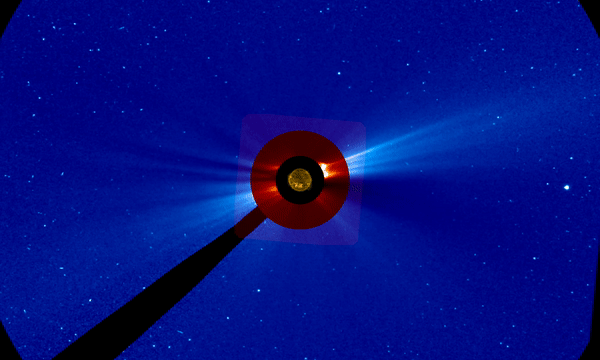A massive outburst from the Sun was felt across three worlds in a rare event that could help protect astronauts from harmful radiation during future missions.
On October 28, 2021, a solar eruption spread across Earth, the Moon, and Mars simultaneously, even as Earth and Mars were around 150 million miles (250 million kilometres) apart on opposite sides of the Sun, according to a recent paper published in Geographical Research Letters. This marks the first time the Sun’s explosive outburst was measured on three different bodies, and provides a better understanding of solar activity and how it can affect spaceflight.
The coronal mass ejection (CME) was detected by a fleet of spacecraft that included the European Space Agency’s (ESA) ExoMars Trace Gas Orbiter, NASA’s Curiosity Mars rover and its Lunar Reconnaissance Orbiter, China’s Chang’e-4 Moon lander, and Germany’s Eu:CROPIS Earth orbiter. ESA’s Solar Orbiter, SOHO, and BepiColombo missions were also caught in the solar blast.
The Sun is a relatively calm star, but it does sometimes shoot out hot gas, or plasma, in a massive flareup that spreads outwards through the solar system. Earth’s magnetic field protects the planet from the harmful radiation but during a rare ground-level enhancement, particles from the Sun are energetic enough to pass through the magnetic bubble that surrounds Earth, according to ESA.
The event recorded by the multiple spacecraft happened to be a ground-level enhancement whereby the Sun’s particles reached Earth’s surface. The Moon and Mars, on the other hand, are much more affected by these solar outbursts than Earth since they do not generate their own magnetic fields. Therefore, particles from the Sun easily penetrate the Moon and the thin atmosphere on Mars to reach their surface, interacting with the soil to produce a secondary wave of radiation. Compared to the Moon, however, Mars’ thin atmosphere does manage to stop most of the lower energy particles while slowing down the highly energetic ones.
NASA recently kicked off its Artemis program, through which the space agency hopes to establish a sustainable presence of astronauts on the Moon. Therefore, it is extremely crucial to understand the Sun’s outbursts in order to protect future astronauts from harmful solar radiation.
“A radiation dose above 700 milligray – the unit for the absorption of radiation – may induce radiation sickness via destruction of the bone marrow, resulting in symptoms such as infection and internal bleeding,” ESA wrote. “If an astronaut receives more than 10 gray, they are extremely unlikely to survive more than two weeks.”
The solar storms that took place in August 1972 would have been extremely dangerous for astronauts on the Moon, giving them a high dosage of radiation. Luckily, the storms occurred between the Apollo 16 and Apollo 17 missions so no astronauts were caught on the lunar surface.
“Our calculations of the past ground-level enhancement events show that on average one event every 5.5 years may have exceeded the safe dose level on the Moon if no radiation protection had been provided,” Jingnan Guo, a heliophysics researcher at the University of Science and Technology of China, is quoted as saying in the ESA statement.
There are ongoing mitigation efforts designed to protect astronauts from solar radiation during missions to the Moon. NASA’s Lunar Gateway, a planned orbital outpost around the Moon, will be equipped with three suites of instruments to monitor the radiation environment around the Moon. The Artemis 1 mission also tested a protective vest worn by a manikin that travelled to the Moon and back in late 2022.
These mitigation efforts are only useful if scientists are able to better predict the Sun’s activity and know when the star will flare up with a burst of hot gas. “Currently, we live in a golden age of Solar System physics,” Marco Pinto, ESA research fellow working on radiation detectors, said in the statement. “Radiation detectors aboard planetary missions such as BepiColombo, on its way to Mercury, and Juice, cruising to Jupiter, add a much-needed coverage to study the acceleration and propagation of solar energetic particles.”
